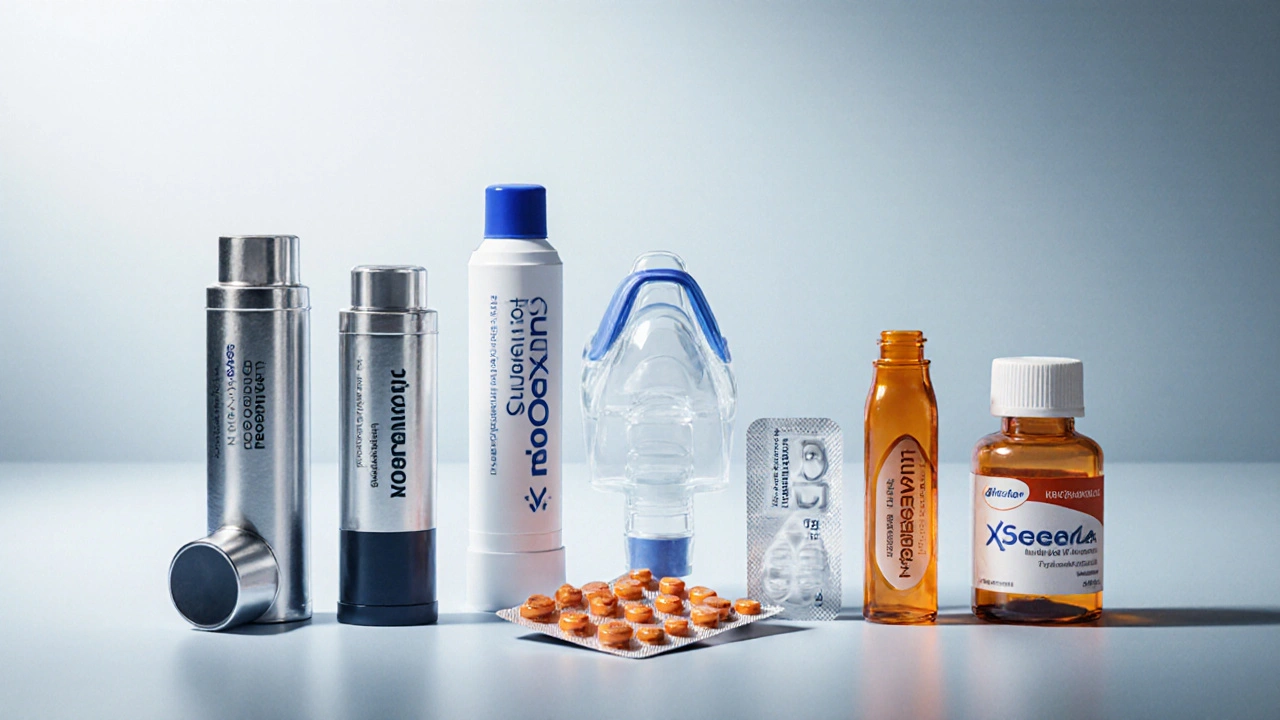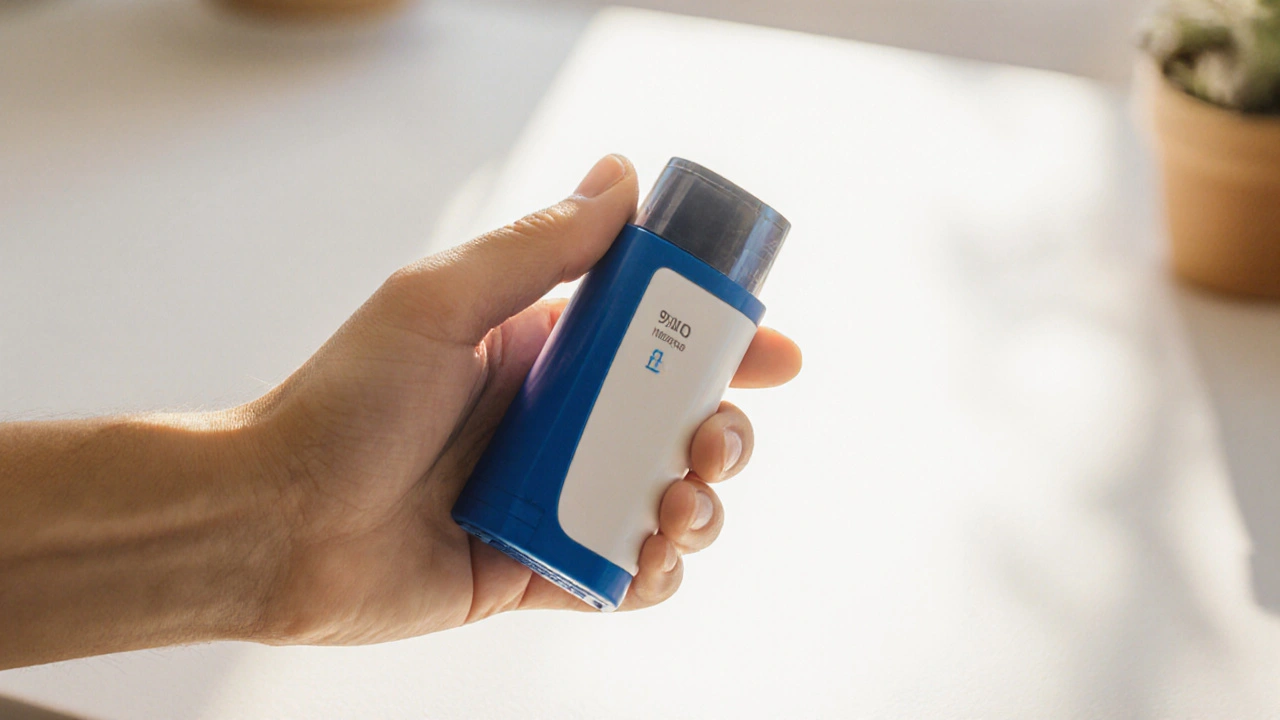Asthma Medication Finder
Find Your Best Asthma Medication
Select your preferences to find the most suitable alternative to Ventolin for your needs.
Your Recommended Option
Onset
Duration
Cost
Why This Option?
Key Takeaways
- Ventolin is a fast‑acting albuterol inhaler, but several other bronchodilators and controller meds may fit your lifestyle better.
- Onset and duration vary widely: albuterol products act in minutes but wear off in a few hours, whereas long‑acting agents last up to 12hours.
- Prescription status, price, and insurance coverage often decide which alternative you’ll actually use.
- Side‑effect profiles differ - levalbuterol tends to cause fewer jittery feelings, while oral theophylline can affect sleep.
- Choosing the right option means matching your asthma severity, rescue‑vs‑maintenance needs, and personal preferences.
If you’ve ever wondered whether that familiar blue‑and‑white inhaler is your only rescue option, you’re not alone. Ventolin alternatives have multiplied over the past decade, and the market now offers a mix of brand‑name and generic products that differ in speed, duration, cost, and side‑effects. This guide walks you through the most common substitutes, shows how they stack up in a side‑by‑side table, and gives you practical pointers for picking the one that actually works for your day‑to‑day breathing.
What is Ventolin?
Ventolin is a brand‑name inhaler that delivers the generic drug albuterol, a short‑acting beta‑2 agonist (SABA) designed to relax airway muscles quickly. First approved in the 1980s, it remains a staple in rescue kits for asthma and chronic obstructive pulmonary disease (COPD). The inhaler uses a metered‑dose spray (MDI) that releases 90µg of albuterol per puff, providing relief within 5‑15minutes that typically lasts 4‑6hours.
Why Look at Alternatives?
Ventolin works well for many, but a few common reasons drive patients to explore other options:
- Speed vs. duration: Some people need a bit more runway after a flare‑up, especially at night.
- Side‑effects: Albuterol can cause shaking, rapid heartbeat, or throat irritation.
- Formulation preferences: MDIs require coordination; some prefer dry‑powder inhalers (DPIs) or nebulizer solutions.
- Cost & insurance: Generic albuterol is cheap, yet certain insurers push patients toward preferred brands.
- Maintenance needs: For frequent symptoms, a long‑acting bronchodilator or controller medication may be more efficient.
Understanding these factors helps you weigh the pros and cons of each alternative.
How to Compare Rescue and Controller Options
We’ll measure each product on six criteria that matter most when you’re deciding:
- Onset of action - How fast you feel relief.
- Duration of effect - How long the symptom‑free window lasts.
- Delivery device - MDI, DPI, nebulizer, or oral.
- Prescription requirement - Over‑the‑counter (OTC) vs. prescription only.
- Typical cost - List price and common insurance tier.
- Side‑effect profile - Common and serious reactions.

Side‑by‑Side Comparison Table
| Brand | Generic name | Delivery | Onset | Duration | Prescription? | Typical cost (USD) | Notable side‑effects |
|---|---|---|---|---|---|---|---|
| Ventolin | Albuterol | MDI (90µg/puff) | 5‑15min | 4‑6hrs | Prescription (some OTC in limited states) | $15‑$30 for 200‑act inhaler | Tremor, tachycardia, throat irritation |
| ProAir HFA | Albuterol | MDI (90µg/puff) | 5‑10min | 4‑6hrs | Prescription | $20‑$35 | Similar to Ventilator; slightly less throat irritation |
| Proventil HFA | Albuterol | MDI (90µg/puff) | 5‑12min | 4‑5hrs | Prescription | $18‑$32 | Potential jitter, dry mouth |
| Xopenex | Levalbuterol | MDI (45µg/puff) / Nebulizer | 7‑12min | 4‑6hrs | Prescription | $30‑$45 | Less tremor, still can cause tachycardia |
| Serevent | Salmeterol | DPI (50µg/act) | 30‑60min | 12‑14hrs | Prescription | $90‑$130 | Rare paradoxical bronchospasm |
| Singulair | Montelukast | Oral tablet (10mg) | 2‑4hrs | 24hrs (daily) | Prescription (often covered) | $25‑$45 per month | Headache, mood changes |
| Symbicort | Budesonide/Formoterol | MDI (80µg/act) | 2‑5min | 12‑24hrs (combo) | Prescription | $120‑$180 | Candidiasis, hoarseness, occasional tachycardia |
| Generic Theophylline | Theophylline | Oral tablet | 30‑60min | 6‑8hrs | Prescription | $10‑$20 per month | Nausea, insomnia, cardiac arrhythmia at high levels |
Deep Dive into Each Alternative
ProAir HFA
ProAir HFA is another albuterol inhaler that uses a hydrofluoroalkane propellant, offering a slightly smoother spray than older CFC versions. Clinical trials show comparable lung‑function improvement to Ventolin, but many patients report a milder after‑taste. If you already own a spacer, ProAir works just as well, and the inhaler’s compact size fits easily in a pocket.
Proventil HFA
Proventil HFA delivers the same 90µg albuterol dose per puff but features a redesigned mouthpiece that reduces aerosol loss for older adults who have coordination challenges.
Because it’s a brand of the same generic drug, insurance plans often treat it interchangeably with Ventolin and ProAir.
Levalbuterol (Xopenex)
Levalbuterol (brand name Xopenex) is the R‑enantiomer of albuterol, meaning it’s the “active” half of the molecule. Studies published in the Journal of Allergy and Clinical Immunology (2023) indicate levalbuterol produces similar bronchodilation with 30‑40% less tremor in children. The trade‑off is a higher price tag and limited generic availability in the U.S. It’s a solid pick if you’re sensitive to the jittery feeling that classic albuterol can cause.
Salmeterol (Serevent)
Salmeterol is a long‑acting beta‑2 agonist (LABA) that you use twice daily for maintenance, not immediate relief. Because it takes 30‑60minutes to kick in, doctors never prescribe it as a rescue inhaler alone. It pairs well with an inhaled corticosteroid (ICS) for moderate‑to‑severe asthma, cutting nighttime symptoms dramatically.
Beware of the FDA’s “black box” warning: using a LABA without an accompanying steroid can raise the risk of severe asthma attacks.
Montelukast (Singulair)
Montelukast is a leukotriene‑receptor antagonist taken as a daily pill. It doesn’t provide rapid bronchodilation, but it reduces inflammation caused by allergens and exercise‑induced asthma. For people who dislike inhalers or have mild persistent symptoms, it’s a convenient oral option. Recent FDA updates (2024) advise clinicians to screen for mood changes, especially in adolescents.
Budesonide/Formoterol (Symbicort)
Symbicort combines an inhaled corticosteroid (budesonide) with a fast‑acting LABA (formoterol) in a single MDI. The device works as both a rescue and a maintenance inhaler, giving you flexibility for up‑to‑24‑hour coverage. Its rapid onset (2‑5minutes) rivals albuterol, while the anti‑inflammatory component keeps underlying airway swelling in check.
Because it’s a combo, insurance plans often place it in a higher tier, so check your formulary before switching.
Theophylline (generic)
Theophylline is an oral bronchodilator that has been used for decades. It works by inhibiting phosphodiesterase, which relaxes airway smooth muscle. Blood‑level monitoring is required for some patients, as the therapeutic window is narrow. It’s rarely first‑line today but can be a useful adjunct when inhalers aren’t enough or when a patient can’t tolerate them.
Choosing the Right Option for You
Here’s a quick decision tree you can run in your head after a wheeze:
- If you need instant relief (within 5minutes) and only a few puffs, stick with a SABA - Ventolin, ProAir, Proventil, or levalbuterol.
- If you experience symptoms more than twice a week, add a controller like inhaled corticosteroid (ICS) or a LABA/ICS combo (e.g., Symbicort).
- If you’re an athlete or have exercise‑induced asthma, consider Montelukast as a daily oral supplement.
- If you’re sensitive to tremor or have a fast heart rate, try levalbuterol before moving to a more expensive brand.
- If you prefer a non‑inhaler route and can tolerate oral meds, theophylline might fill gaps, but discuss blood‑level checks with your doctor.
Ultimately, the best rescue inhaler is the one you’ll carry and use correctly. Talk to your pulmonologist about insurance formulary restrictions; many plans favor generic albuterol, but a small co‑pay for levalbuterol can be worth the comfort.
Side‑Effect Snapshot
All bronchodilators speed up heart rate to some degree. Here’s what to watch for:
- Tremor & jitteriness: Most common with albuterol; levalbuterol reduces this by ~35%.
- Throat irritation: Often mitigated by rinsing mouth after each puff.
- Paradoxical bronchospasm: Rare but serious; stop the inhaler and seek help if breathing worsens immediately.
- Mood changes: Linked to montelukast, especially in teens.
- Cardiac arrhythmia: High doses of theophylline can trigger irregular beats - monitor levels.

Cost & Insurance Realities (2025)
Generic albuterol (Ventolin, ProAir, Proventil) typically costs $10‑$25 for a 200‑act inhaler when you use a pharmacy discount card. Levalbuterol sits at $30‑$45, while combo inhalers like Symbicort often exceed $120 per month. Some Medicare PartD plans cover montelukast fully, making it a cost‑effective oral route.
Ask your pharmacist about “discount programs” such as GoodRx or manufacturer coupons. Many brand‑name inhalers offer a free‑sample starter pack if you mention you’re starting a new therapy.
Practical Tips for Using Any Inhaler
- Shake the MDI for at least one second before each use.
- Exhale fully, place the mouthpiece, then inhale slowly while pressing down - this maximizes drug deposition.
- Hold your breath for about 10seconds after inhalation.
- Clean the mouthpiece weekly with warm water; let it air‑dry.
- Replace the inhaler when the counter hits “0” or after 12months, even if doses remain.
Final Thought
There’s no one‑size‑fits‑all answer to “what’s the best rescue inhaler?” You’ve now seen how Ventolin stacks up against its peers, what each alternative brings to the table, and how cost, side‑effects, and daily usage patterns shape the decision. Use this guide as a checklist during your next doctor visit - the more you know, the easier it is to get a prescription that truly fits your life.
Frequently Asked Questions
Is Ventolin safer than other albuterol inhalers?
All albuterol MDIs share the same active ingredient, so safety profiles are virtually identical. Minor differences come from propellant type or mouthpiece design, which may affect irritation but not systemic risk.
When should I consider switching to levalbuterol?
If you notice frequent tremors, palpitations, or anxiety after using albuterol, levalbuterol often provides the same relief with fewer nervous‑system side effects. Discuss the switch with your pulmonologist, especially if your insurance covers it.
Can I use a LABA like salmeterol as a rescue inhaler?
No. LABAs take 30‑60 minutes to start working, which is far too slow for an asthma attack. They must always be paired with an inhaled corticosteroid and used for maintenance only.
Is an oral asthma pill like montelukast a replacement for inhalers?
Montelukast helps control inflammation but does not provide rapid bronchodilation. Most doctors recommend keeping a rescue inhaler on hand even if you take a daily leukotriene blocker.
How often should I replace my albuterol inhaler?
Replace it when the dose counter reads “0” or after 12months, whichever comes first. The propellant degrades over time, reducing effectiveness.


Brett Coombs
October 12, 2025 AT 01:53Don't trust the pharma pushing Ventolin they just want your wallet.
John Hoffmann
October 12, 2025 AT 21:19Actually, the previous remark contains a run‑on sentence and lacks proper punctuation. A clearer version would be: "Don't trust the pharmaceutical companies promoting Ventolin; they merely want your money." Additionally, capitalize "Ventolin" and use a semicolon to separate independent clauses.
Shane matthews
October 13, 2025 AT 16:46I get the concern but it's best to check with a doctor before assuming motives.
Rushikesh Mhetre
October 14, 2025 AT 12:13Alright folks, let's break this down with some energy!
Ventolin works fast, but you have options-Levalbuterol cuts tremor, ProAir saves a few bucks, and Symbicort covers both rescue and maintenance!
Don't forget the oral route: Montelukast for allergy‑driven asthma, and even the old‑school Theophylline if you need a backup.
Each delivery method has its quirks-MDIs need coordination, DPIs demand a strong inhale, nebulizers are great for kids, and oral pills sidestep inhaler technique altogether!
Cost-wise, generic albuterol is a steal, while combo inhalers can strain a budget; always check pharmacy discounts!
Bottom line: match the drug to your lifestyle, not the other way around!
Sharath Babu Srinivas
October 15, 2025 AT 07:39Great recap! 😊 Just a tiny note: the word "side‑effect" should be hyphenated, and "saves a few bucks" could be "saves a few dollars." 👍
Halid A.
October 16, 2025 AT 03:06When weighing Ventolin against its alternatives, it helps to start with the clinical endpoints that matter most to patients.
First, the onset of action determines how quickly relief is felt during an acute bronchospasm.
Albuterol products, including Ventolin, typically act within five to fifteen minutes, which remains unmatched by most long‑acting agents.
Second, duration of effect influences how often a rescue inhaler must be carried and used.
Ventolin’s four‑to‑six hour window is sufficient for most intermittent attacks but may require a repeat dose for night‑time symptoms.
Third, side‑effect profiles differ subtly; tremor and tachycardia are common with albuterol, while levalbuterol reduces tremor by roughly a third.
Fourth, delivery device preference can affect adherence; some patients struggle with the hand‑breath coordination needed for MDIs.
Dry‑powder inhalers eliminate the coordination step but demand a forceful inhalation that not everyone can achieve.
Fifth, cost remains a decisive factor, especially for those without comprehensive insurance.
Generic albuterol inhalers often sit under twenty dollars, whereas branded levalbuterol or combination inhalers like Symbicort can exceed a hundred dollars per month.
Sixth, insurance formularies sometimes mandate a step‑therapy approach, starting with the cheapest acceptable product before approving a pricier alternative.
Seventh, the distinction between rescue and controller therapy is crucial; LABAs such as salmeterol are never appropriate for acute relief.
Eighth, patient education on proper inhaler technique can mitigate throat irritation and improve drug deposition.
Ninth, adjunctive therapies like montelukast address the inflammatory component but do not replace a rescue inhaler.
Finally, shared decision‑making with a clinician ensures that the chosen medication aligns with lifestyle, comorbidities, and personal tolerance for side effects.
Brandon Burt
October 16, 2025 AT 22:33Okay, I see the long list, but honestly, most people just need a cheap inhaler that works, and all this fancy talk about combos and LABAs feels like a marketing ploy, you know, like they’re trying to overcomplicate something simple, and the reality is you get a short‑acting inhaler, you use it when you wheeze, you rinse your mouth, and you’re done-no need for endless tables and bullet points that only a pharmacist would read.
Gloria Reyes Najera
October 17, 2025 AT 17:59Honestly, anyone who reads this guide and still thinks Ventolin is the only option is definately missing the point, you should check out the other meds-they are not just alote of hype, they actually work better for many people.
Gauri Omar
October 18, 2025 AT 13:26Hold on! Let's get dramatic for a second-imagine battling a relentless asthma attack while the world tells you the blue inhaler is your only ally!
That narrative is a trap. You deserve choices, you deserve a medication that doesn't make your hands shake like a leaf in a storm.
Grab the facts, demand the right fit, and don't settle for the first thing they hand you!
Willy garcia
October 19, 2025 AT 08:53For anyone still unsure, start with a generic albuterol inhaler, track how often you need it, and discuss any side‑effects with your provider.
zaza oglu
October 20, 2025 AT 04:19Let's celebrate the diversity of options! 🌈 Each inhaler, tablet, or nebulizer brings its own rainbow of benefits-find the hue that matches your life.
Vaibhav Sai
October 20, 2025 AT 23:46Absolutely! 🎉 When you pair the right device with a solid technique, you unlock the full spectrum of relief-no more guessing, just confidence.
Lindy Swanson
October 21, 2025 AT 19:13Sure, but who even needs an alternative when the original works fine for most, right?